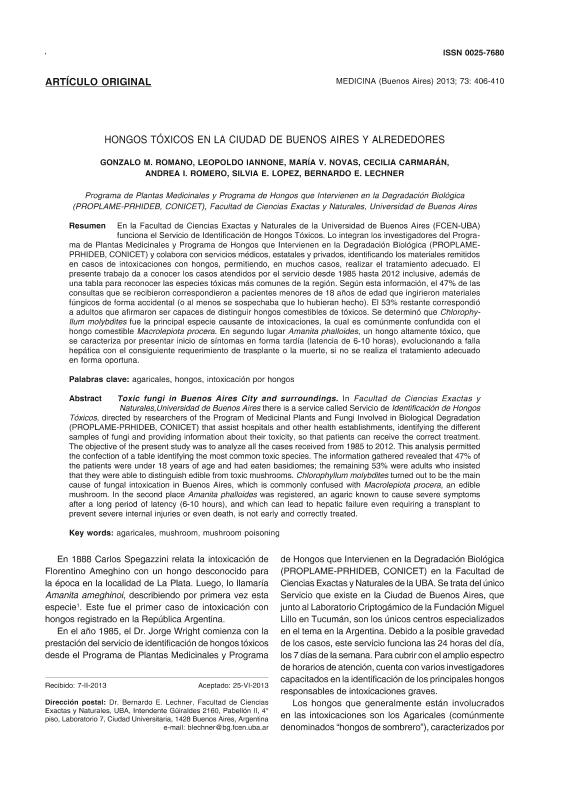Artículo
En la Facultad de Ciencias Exactas y Naturales de la Universidad de Buenos Aires (FCEN-UBA) funciona el Servicio de Identificación de Hongos Tóxicos. Este Servicio está formado por los investigadores del Instituto PROPLAME-PRHIDEB (CONICET) y colabora con diversos servicios médicos, tanto estatales como privados, identificando los materiales remitidos cuando se presentan casos de intoxicaciones con hongos, permitiendo, en muchos casos, realizar el tratamiento adecuado. El presente trabajo da a conocer los casos atendidos por el servicio desde 1985 hasta 2012. Además se elaboró una clave dicotómica para reconocer las especies tóxicas más comunes de la región. Según la información recopilada, el 47% de las consultas que se recibieron correspondieron a pacientes menores de 18 años de edad que ingirieron materiales fúngicos de forma accidental (o al menos se sospechaba que lo hubieran hecho). El 53% restante correspondió a adultos que afirmaron ser capaces de distinguir hongos comestibles de tóxicos. Se determinó que Chlorophyllum molybdites fue la principal especie causante de intoxicaciones, la cual es comúnmente confundida con el hongo comestible Macrolepiota procera. En segundo lugar Amanita phalloides, un hongo altamente tóxico, el cual se caracteriza por presentar inicio de síntomas de forma tardía (latencia de 6-10 horas), evolucionando a falla hepática con el consiguiente requerimiento de trasplante o la muerte, si no se realiza el tratamiento adecuado en forma oportuna. In Facultad de Ciencias Exactas y Naturales,Universidad de Buenos Aires there is a service called Servicio de Identificación de Hongos Tóxicos, directed by researchers of the Program of Medicinal Plants and Fungi Involved in Biological Degradation (PROPLAME-PRHIDEB, CONICET) that assist hospitals and other health establishments, identifying the different samples of fungi and providing information about their toxicity, so that patients can receive the correct treatment. The objective of the present study was to analyze all the cases received from 1985 to 2012. This analysis permitted the confection of a table identifying the most common toxic species. The information gathered revealed that 47% of the patients were under 18 years of age and had eaten basidiomes; the remaining 53% were adults who insisted that they were able to distinguish edible from toxic mushrooms. Chlorophyllum molybdites turned out to be the main cause of fungal intoxication in Buenos Aires, which is commonly confused with Macrolepiota procera, an edible mushroom. In the second place Amanita phalloides was registered, an agaric known to cause severe symptoms after a long period of latency (6-10 hours), and which can lead to hepatic failure even requiring a transplant to prevent severe internal injuries or even death, is not early and correctly treated.
Hongos causantes de intoxicación en la Ciudad de Buenos Aires y alrededores, Argentina
Romano, Gonzalo Matías; Iannone, Leopoldo Javier ; Novas, María Victoria
; Novas, María Victoria ; Carmaran, Cecilia Cristina
; Carmaran, Cecilia Cristina ; Romero, Andrea Irene
; Romero, Andrea Irene ; Lopez, Silvia Edith
; Lopez, Silvia Edith ; Lechner, Bernardo Ernesto
; Lechner, Bernardo Ernesto
 ; Novas, María Victoria
; Novas, María Victoria ; Carmaran, Cecilia Cristina
; Carmaran, Cecilia Cristina ; Romero, Andrea Irene
; Romero, Andrea Irene ; Lopez, Silvia Edith
; Lopez, Silvia Edith ; Lechner, Bernardo Ernesto
; Lechner, Bernardo Ernesto
Fecha de publicación:
07/2013
Editorial:
Medicina (buenos Aires)
Revista:
Medicina (buenos Aires)
ISSN:
0025-7680
e-ISSN:
1669-9106
Idioma:
Español
Tipo de recurso:
Artículo publicado
Clasificación temática:
Resumen
Palabras clave:
Agaricales
,
Hongos
,
Intoxicación por Hongos
Archivos asociados
Licencia
Identificadores
Colecciones
Articulos(INMIBO (EX - PROPLAME))
Articulos de INSTITUTO DE MICOLOGIA Y BOTANICA
Articulos de INSTITUTO DE MICOLOGIA Y BOTANICA
Articulos(OCA CIUDAD UNIVERSITARIA)
Articulos de OFICINA DE COORDINACION ADMINISTRATIVA CIUDAD UNIVERSITARIA
Articulos de OFICINA DE COORDINACION ADMINISTRATIVA CIUDAD UNIVERSITARIA
Articulos(SEDE CENTRAL)
Articulos de SEDE CENTRAL
Articulos de SEDE CENTRAL
Citación
Romano, Gonzalo Matías; Iannone, Leopoldo Javier; Novas, María Victoria; Carmaran, Cecilia Cristina; Romero, Andrea Irene; et al.; Hongos causantes de intoxicación en la Ciudad de Buenos Aires y alrededores, Argentina; Medicina (buenos Aires); Medicina (buenos Aires); 73; 7-2013; 403-406
Compartir



